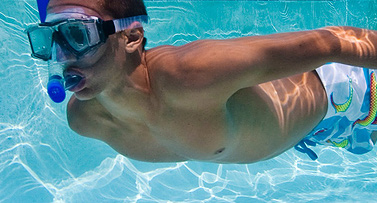11/09/2017What Are The Most Common Types of Inground Swimming Pools?
For those looking for a backyard pool that is cleaner than a simple hole in the mud and more attractive than traditional above-ground pools, there are four primary types of inground pools to consider. Wood is a potential option, but its lack of durability prevents it from being a popular choice for homeowners. Wooden pools will deteriorate rapidly in only a few years. This narrows the choice of materials. There can be variations even within the four main types, allowing for a greater choice when designing your pool.
Concrete with Aggregate or Plaster Finish
The most common inground pool material is concrete and plaster. It has been a prominent choice since recreational pools first gained popularity. Because of its porous nature, its concrete remains durable while the plaster shell is able to retain water and maintain stability. It is relatively easy to repair.
Once the initial hole has been excavated at the pool site, the sides and bottom are framed with steel rods (known as ‘rebar’). Because of their flexibility, they can be manipulated into many shapes beyond a simple rectangle. Once they have been positioned, the concrete is poured. Then a finish made of shotcrete or gunite is sprayed over the concrete. Because working with rebar is relatively easy, designing a pool with curves does not generally cost much more than the traditional rectangle.
Finish Alternatives
Keeping concrete as a base, other finishes can be substituted to provide variation on your pool surface. Common options include stone, tile, or other man-made textures. These alternate textures, like pebble, are becoming very popular. One can expect these finishes to last about eight to twelve years.
Fiberglass
Inground pools made of fiberglass are often sold as one large shell piece that will be delivered by a truck to your home. Once the pool site has been excavated, this fiberglass shell will be lowered into the hole, guided by a crane. Fiberglass pool shells are ready-made, which makes customization difficult and costly. However, most manufacturers offer several different choices in shell model.
Because of its one-piece design, installing a fiberglass pool is simple and fast. The surface is smooth and clean, which significantly reduces algae build-up. The drawbacks are the fact that after ten or fifteen years of exposure to sunlight, fiberglass can deteriorate. Repairing or re-finishing the shell is difficult. Fiberglass can be a more costly model.
Vinyl
Pools that use vinyl are constructed above ground using metal or plastic frames, then set into the hole at the excavation site, similar to the fiberglass model. Support walls made of pre-fabricated material are added to the frame and then lined with heavy vinyl. The bottom of the pool will sit on a bed of sand, while the top portion of the frame is secured by coping.
As with fiberglass, exposure to sunlight weakens vinyl over time, but some models do come with UVB inhibitors, which can increase the life from ten to approximately eighteen years.
If you have questions about inground swimming pools or you are interested in installing one on your property, do not hesitate to contact Sundays Off Pools online or by calling 763-546-1651.



